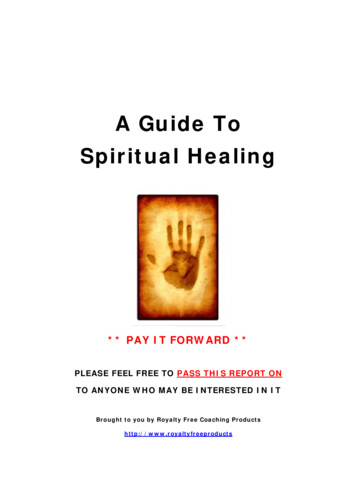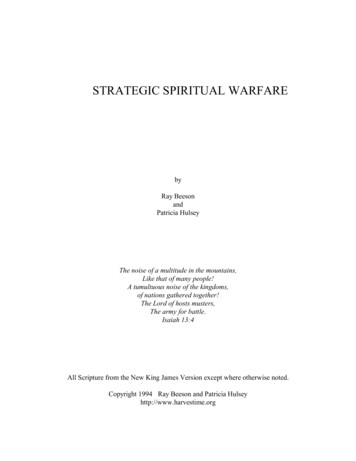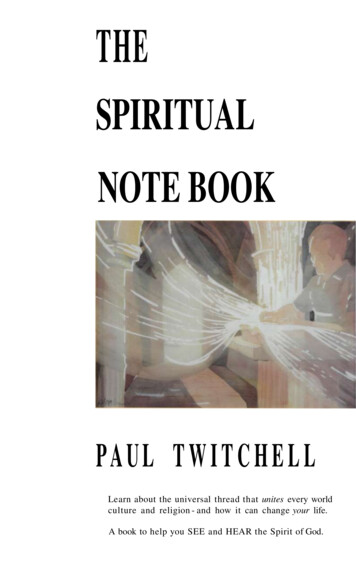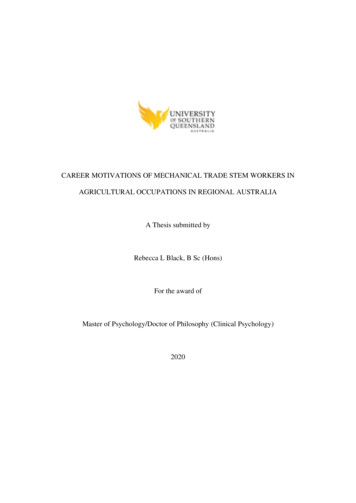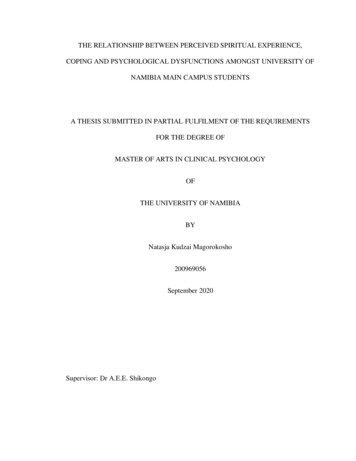
Transcription
THE RELATIONSHIP BETWEEN PERCEIVED SPIRITUAL EXPERIENCE,COPING AND PSYCHOLOGICAL DYSFUNCTIONS AMONGST UNIVERSITY OFNAMIBIA MAIN CAMPUS STUDENTSA THESIS SUBMITTED IN PARTIAL FULFILMENT OF THE REQUIREMENTSFOR THE DEGREE OFMASTER OF ARTS IN CLINICAL PSYCHOLOGYOFTHE UNIVERSITY OF NAMIBIABYNatasja Kudzai Magorokosho200969056September 2020Supervisor: Dr A.E.E. Shikongo
ABSTRACTThe aim of this study was to explore the role that spiritual experience plays in copingwith psychological dysfunctions (stress, anxiety and depression) amongst University ofNamibia students. The target population were all full time students at the main campus,a total of 13 575. The study sampled 388 students, using the random sampling technique.Three questionnaires were administered to collect data, namely the Socio-DemographicQuestionnaire (SDQ), the Daily Spiritual Experience’s Scale (DSES) and the DepressionAnxiety Stress Scale (DASS). A Pearson correlation coefficient was carried out tomeasure the strength and direction of the relationships that exists amongst spiritualexperience, stress, anxiety and depression among University students. The key findingsfrom the study indicated that there was no significant correlation between spiritualexperience and stress. The study further did not find a significant correlation betweenspiritual experience and anxiety. However, the study found a significant but weaknegative correlation between spiritual experience and depression. The data also showedthat individuals with no spiritual experience tend to feel overwhelmed and more stressedas they hold themselves accountable for every situation.i
TABLE OF CONTENTSABSTRACT . iLIST OF TABLES . viLIST OF ABBREVIATIONS AND ACRONYMS . viiACKNOWLEDGEMENTS . viiiDEDICATION . ixDECLARATIONS . xCHAPTER 1: INTRODUCTION. 11.1 Background of the Study . 11.2 Statement of the Problem . 41.3 Hypothesis . 51.4 Objectives of the Study . 51.5 Significance of the Study. 51.6 Limitations . 51.7 Delimitations of the Study . 61.8 Definitions of Terms . 6CHAPTER 2: LITERATURE REVIEW . 92.1 Global Overview of Religion as a Spiritual Experience . 92.2University Students Coping with Stress, Anxiety and Depression . 112.3Spiritual Experience as a Faith-based Coping Mechanism . 162.4Spiritual Experience in Coping with and Managing Stress . 192.5Spiritual Experience in Coping with and Managing Anxiety . 192.6Spiritual Experience in Coping with and Managing Depression . 20ii
2.7Theoretical Framework . 21CHAPTER 3: RESEARCH METHODS . 253.1Research Design . 253.2Population . 253.3Sample . 263.4Research Instruments . 263.4.1. Socio-Demographic Questionnaire . 263.4.2. The Daily Spiritual Experiences Scale (DSES) . 263.4.3. The Depression Anxiety Stress Scale (DASS). 283.5Procedure. 293.6Data Analysis . 293.7 Research Ethics . 29CHAPTER 4: PRESENTATION OF DATA . 314.1 Demographic Data . 314.2 Empirical Data . 35CHAPTER 5: DISCUSSION OF RESULTS AND RESEARCH FINDINGS . 375.1 Demographic Data . 375.2 Empirical Data . 39CHAPTER 6: CONCLUSIONS AND RECOMMENDATIONS . 456.1Conclusions . 456.2Limitations . 456.3Recommendations. 466.4Future Research . 47APPENDICES . 64iii
APPENDIX A. 64Ethical Clearance Certificate & Permission Letter . 64APPENDIX B . 66Consent Form &Demographic Questionnaire . 66APPENDIX C . 68Depression Anxiety Stress Scale (DASS-21) . 68APPENDIX E . 70Daily Spiritual Experience Scale (DSES) . 70iv
LIST OF FIGURESFigure 1 Theoretical model of casual pathways for mental health (MH), based onWestern monotheistic religions (Christianity, Judaism, and Islam). Koenig, King, &Carson, 2012) . 24Figure 2: Pie chart showing gender distributions of participants . 31Figure 3: Pie chart showing the age distribution of the participants. . 32Figure 4: Pie chart showing the distribution of participants by year of study . 33v
LIST OF TABLESTable 1 Means and Standard Deviation of the age of participants . 32Table 2 Mean and Standard deviation of participant‟s responses on Total Global scales. 34Table 3 Prevalence of depression, anxiety and stress amongst UNAM students . 35Table 4 Correlation of spiritual experience and stress, anxiety and depression . 36vi
LIST OF ABBREVIATIONS AND ACRONYMSAPAAmerican Psychology AssociationCBPRCommunity Based Participatory ResearchDASSDepression Anxiety Stress ScaleDSESDaily Spiritual Experiences ScaleFBMHPFaith Based Mental Health PromotionSDQSocio-Demographic QuestionnaireSPSSStatistical Package for Social SciencesWHOWorld Health Organizationvii
ACKNOWLEDGEMENTSI would like to express my sincere gratitude to my supervisor Dr Armas E.E Shikongo.He has been encouraging and supportive throughout my studies and for his guidancethroughout the entire process of my growth as a post-graduate student. Your advice onboth my career and research is invaluable and lasting. Thank you for sharing yourknowledge with me as a supervisor and mentor.I also wish to thank the United Methodist Women, The International Ministries withWomen, Children and Youth Scholarship (IMC) Program for the financial assistancethat made this journey possible.A special thanks to my family. Words cannot express how grateful I am to my mother,Rose Magorokosho for all the sacrifices that she has made for me, as well as the prayersthat continue to sustain me. I would also like to thank my friends especially SelmaUugwanga who supported me in my academic research, and encouraged me to strivetowards my goal. Last but not least I wish to express my deep appreciation to mybeloved husband, Munyaradzi Tambo, who was always there in times when there was noone to answer my queries.viii
DEDICATIONThis thesis is lovingly dedicated to my mother, Rose Magorokosho, my husbandMunyaradzi Tambo and my extended family for their support, encouragement, andconstant love that has sustained me throughout my life.ix
DECLARATIONSI, Natasja Kudzai Magorokosho, hereby declare that this study is my own work and is atrue reflection of my research, and that this work, or any part thereof has not beensubmitted for a degree at any other institution.No part of this thesis/dissertation may be reproduced, stored in any retrieval system, ortransmitted in any form, or by means (e.g. electronic, mechanical, photocopying,recording or otherwise) without the prior permission of the author, or the University ofNamibia in that behalf.I, Natasja, Kudzai Magorokosho, grant the University of Namibia the right to reproducethis thesis in whole or in part, in any manner or format, which the University of Namibiamay deem fit.Natasja Kudzai MagorokoshoName of StudentApril 2020SignaturexDate
CHAPTER 1: INTRODUCTION1.1 Background of the StudyStress, anxiety, and depression are psychological dysfunctions and have been mentionedby the World Health Organization (WHO) as significant mental health disorders(Johannessen-Henry, Deltour, Bidstrup, Dalton, & Johansen, 2013). WHO furtherelaborated that stress; anxiety, depression and other mood disorders share theunfortunate distinction of being the most prevalent causes of chronic illnesses (Rentala,Lau, & Chan, 2017). Among the global burden of diseases, stress, anxiety anddepression are the fourth leading contributors to morbidity and mortality and it has beenprojected that by 2020, they will become the second leading contributors after thecardiovascular-related diseases (Rentala, Lau, & Chan, 2017).Depression is a common mental disorder, characterized by sadness, loss of interest orpleasure, feelings of guilt or low self-worth, disturbed sleep or appetite, low energy andpoor concentration (Marcus, Yasamy, Van Ommeren, Chisholm, & Saxena, 2012).Anxiety is considered as a state of uneasiness and it is a bodily response to a perceiveddanger that could be real or imaginary and triggered by an individual‟s thoughts, beliefsor feelings. Various studies have found that anxiety disorders are rising among students(Vitasari, Wahab, Othman & Awang, 2010). There are several empirical studies thathave specifically investigated the relationship between spiritual experience and anxietydisorders. Shreve-Neiger and Edelstein (2004) state that having some type of religiousaffiliation/spiritual experience appears to be related to lower anxiety levels in the generalpopulation. Empirical studies have also found that there is a link between stress and1
depression (Hamilton & Alloy, 2017; Hamilton &Alloy, 2016; Hamilton, Stange,Shapero, Connolly, Abramson, & Alloy, 2013); these studies report that high stresslevels are correlated with depression.Stress, on the other hand, is a consequence of, or a general response to, an action orsituation that places special physical and/or psychological demands, on a person(Johannesen- Henry, Deltour, Bidstrup, Dalton, & Johansen, 2013). As such, stressinvolves an interaction of the person with the environment.In general, everyone experiences these mental health disorders; however, university lifeis a stressful phase for many students as they go through the process of adapting to neweducational and social environments (Gallagher, Mehta, Selvan, Mirza, Radia, Bharadia,& Hitch, 2014; Dessie, Ebrahin, & Awoke, 2013). They need to adjust themselves withan environment which requires compliance with new social norms and new friendships(Bhandari, 2012). Moreover, the increasing demand to perform well academically maycontribute to increasing levels of stress, anxiety and depression. According to Ribeiro,Pereira, Freire, de Oliveira, Casotti and Boery (2018) as stressors accumulate; anindividual‟s ability to cope or readjust can be strained, reducing their physical andpsychological resources.Some other empirical studies found that an individual‟s spiritual experience seems to berelated to stress resilience and lower levels of psychological distress (JohannesenHenry, Deltour, Bidstrup, Dalton, & Johansen, 2013).McSherry and Jamieson (2010) define spiritual experience as the presence of arelationship with a Higher Power, a response to a deep and mysterious human yearning2
for self-transcendence and surrender, a yearning to find our place and the search for theexistential. Spirituality has been defined in numerous ways, this includes a belief in aPower operating in the universe that is greater than oneself, a sense of interconnectedness with all living creatures and awareness of the purpose and meaning of lifeand the development of personal absolute values (Saleem, 2017). As a related concept tospirituality, religion is structured beliefs, theology, religious traditions and codes ofconduct (Blazer, 2012). The concepts of spirituality and religion tend to be usedinterchangeably, which can be confusing, as there is a subtle difference between the two,especially when one talks of spiritual experience. The difficulty in isolating spiritualexperience from religion as a valid construct has given rise to concerns about how it ismeasured (Bonelli & Koening, 2013). Another related concept is religiosity, which isdefined as "the degree to which a person adheres to his or her religious values, beliefs,and practices and uses them in daily living" (Worthington, Wade, Hight, Ripley,McCullough, Berry, Schmitt, Berry, Bursley, & O‟Conner, 2003).Globally, more than 300 million people suffer from depression, the leading cause ofdisability, and more than 260 million are living with anxiety disorders (Rentala, Lau &Chan, 2017). Many of these people live with both depression and anxiety disorders(Johannessen-Henry, Deltour, Bidstrup, Dalton, & Johansen, 2013).Empirical studies conducted in America reported that mental health problems are on therise among University students and that depressive disorders are the highest amongUniversity students (Luna & MacMillan, 2015). Research data indicates that spiritualexperience may be an important protective factor against the onset and development ofdepressive symptoms (Brown, Carney, Parrish, & Klem, 2013; Daaleman & Kaufman,3
2006). As noted by Rentala, Lau and Chan (2017) therapeutic practices that focus onspiritual experience, rather than religiosity, have been found to harness greater clinicalutility. Thus, it is important to examine the role of spiritual experience in adaptation,coping mechanisms, managing stress, anxiety and depressive disorders, especiallyamongst University students. Based on the review of previous empirical studies citedabove, it is evident that spiritual experience has a significant and positive role in helpingindividuals with spirituality to connect and better deal with various psychologicaldisorders, with particular reference to stress, anxiety and depression.1.2 Statement of the ProblemAs aforementioned, there is a positive and significant relationship between variouspsychological disorders (specifically stress, anxiety and depression) and spiritualexperiences. Preliminary literature review done for this study, specifically, revealed thatthere is a lack of empirical studies in Namibia that have investigated the link betweenspiritual experience and stress, anxiety and depressive disorders. This is, particularly,relevant considering that previous studies conducted in other parts of the world haveshown that one of the focus areas of this study, namely depression is a growing epidemicand, therefore, an area that needs more empirical investigation to develop relevantinterventions.Previous academic studies further found that spiritual experience is an importantprotective factor against the onset and development of stress, anxiety and depressivesymptoms (Brown, Carney, Parrish, & Klem 2013). Therefore, the present study aimedto fill in this apparent dearth of information in the Namibian context.4
1.3 HypothesisPerceived spiritual experience has a positive reductive impact on stress, anxiety anddepression amongst University of Namibia students.1.4 Objectives of the StudyThe research focused on the following specific objectives, to:1.4.1 Assess the role and relationship amongst spiritual experience when dealing withstress, anxiety and depression amongst University of Namibia students.1.4.2 Assess the practical implications of involving spirituality in dealing with mentalhealth problems such as stress, anxiety and depression.1.5 Significance of the StudyThe research findings from this study could provide more insight and be useful formental healthcare professionals and psychological wellness practitioners, sinceunderstanding spiritual experience might lead to better management of depression,anxiety and stress. Furthermore, results from this study could be of interest and use tothe office of the Dean of Students, as being the agency responsible for providingcounselling services to students at the University of Namibia. This is in light of the factthat spiritual experience has also been empirically linked to an increased sense ofmeaning, purpose, resilience, satisfaction and happiness (Pargament, Mahoney, Exline,Jones & Shafranske, 2013).1.6 LimitationsAll participants in this study were University students; therefore, generalizing resultsoutside a University population could be a limitation of this study. Another limitation5
was that the study relied on already formulated questionnaires, which are self-report innature, and generally participants tend to report what they believe the researcher expectsto see, or what reflects positively on their own abilities, knowledge, beliefs, or opinions.As such the data should be interpreted with caution (Denscombe, 2010). Therefore,participants were granted privacy when completing the questionnaire. Anonymity wasalso guaranteed to ensure more honest responses in order to reduce the negative effectsof self-report bias.1.7 Delimitations of the StudyThis study was purposefully narrowed or delimited in several important ways. Forexample, despite diverse conceptualizations of spiritual experience, this concept wasdefined and measured using largely structured instruments. In addition, the populationincluded only University of Namibia students, at only one campus, and from twoacademic levels, that is undergraduate and postgraduate students.1.8 Definitions of TermsSpiritual experience is defined by Plante and Sherman (2001) as a personal, meaningfulself-transcendence in a search for the sacred or the “inner self.” It is not necessarilyrooted in or motivated by a religious institution but does relate to personal beliefs andvalues (Plante & Sherman 2001). It is therefore not bound to evaluation set out by theprecepts of religion. Rayburn (2004) further stated that transcendence is the physicalreality in order to attain contact with the superhuman, the sacred or ultimate reality withthe aim of transformation is central to a spiritual experience.6
Spiritual experience is conceptually defined as the presence of a relationship with aHigher Power, a response to a deep and mysterious human yearning for selftranscendence and surrender, a yearning to find our place and the search for theexistential (McSherry & Jamieson, 2010). For the purpose of the present study, “spiritualexperience” will be measured as the Daily Spiritual Experiences Scale’s operationaldefinitions measured by the Daily Spiritual Experience scale (Underwood, 2006). Lowscores on the Daily Spiritual Experience Scale demonstrate a high spiritual experience.Stress is conceptually defined as „physical, mental, or emotional strain or tension‟, aswell as „a condition or feeling experienced when a person perceives that demandsexceed the personal and social resources the individual is able to mobilize‟ (Pitt,Oprescu, Tapia, & Gray, 2017). Stress is any influence of internal and/or surroundingenvironment on living being which disrupt its homeostasis (Shahsavarani, Ashayeri,Lotfian, & Sattari, 2013). For the purpose of the present study, “stress” will be measuredby the Depression Anxiety Stress Scale (Lovibond &Lovibond, 1995), where scoresrange from 0-21 and can differentiate between individuals with normal, mild, moderate,or severe levels of stress.Depression is a common mental disorder that presents with depressed mood, loss ofinterest or pleasure, decreased energy, feelings of guilt or low self-worth, disturbed sleepor appetite, and poor concentration (American Psychiatric Association, 2013).Depression can be long lasting or recurrent, substantially impairing an individual‟sability to function at work or school or cope with daily life. At its most severe,depression can lead to suicide (Johannessen-Henry, Deltour, Bidstrup, Dalton, &Johansen, 2013). For the purpose of the present study, “depression” will be measured by7
the Depression Anxiety Stress Scale (Lovibond &Lovibond, 1995), where scores rangefrom 0-21 and can differentiate between individuals with normal, mild, moderate, orsevere levels of depression.According to Moss (2002), anxiety is the total response of a human being to threat ordanger. Each experience of anxiety involves a perception of danger, thoughts aboutharm, and a process of physiological alarm and activation (Moss, 2002). Theaccompanying behaviors display an emergency effort toward "fight or flight." TheAmerican Psychiatric Association (APA) (2013) defines anxiety as "an emotioncharacterized by feelings of tension, worried thoughts and physical changes likeincreased blood pressure." For the purpose of the present study, “anxiety” will bemeasured by the Depression Anxiety Stress Scale (Lovibond &Lovibond, 1995), wherescores range from 0-21 and can differentiate between individuals with normal, mild,moderate, or severe levels of anxiety.8
CHAPTER 2: LITERATURE REVIEW2.1 Global Overview of Religion as a Spiritual ExperienceMore than 80% of the global population identifies with a religious group (Hackett,2019). A comprehensive demographic study of more than 230 countries and territoriesconducted by the Pew Research Center‟s Forum on Religion & Public Life estimatesthat there are 5.8 billion religiously affiliated adults and children around the globe,representing 84% of the estimated 2010 world population of 6.9 billion (Kennedy,Macnab, & Ross, 2015). According to the Pew Research (2012), the demographic study– based on analysis of more than 2,500 censuses, surveys and population registers –finds 2.2 billion Christians (32% of the world‟s population), 1.6 billion Muslims (23%),1 billion Hindus (15%), nearly 500 million Buddhists (7%) and 14 million Jews (0.2%)around the world as of 2010.According to Kennedy, Macnab and Ross (2015), as a related phenomenon withreligion, the geography of spirituality, however, has been described as a complex andmultidimensional construct that appears to have two distinct components: (1) anexistential dimension and (2) a relational dimension (Brown, Carney, Parrish, & Klem,2013). The existential dimension encompasses the search for meaning in life thatinvolves a sense of connection to oneself, and to the broader environment (Adams &Bezner, 2000). Luna and MacMillan (2015) further elaborated that this sense ofconnection and meaning in life seems to buffer the effect of mental health problemsproviding individuals with an effective way of dealing with stress. On the other hand,the relational dimension of spirituality concerns an individual‟s relationship with God ora Higher Power (Adams & Bezner, 2000) and distribution of religious groups varies9
considerably. Zinnbauer and Pargament (2005) have noted that religion was originallydefined in terms of both substantive and functional dimensions. The substantive aspectsof religion referred to the object of religious pursuits (such as worshipping the sacred)while the functional aspects of religion referred to the purpose of religious pursuits, suchas dealing with existential issues (Zinnbauer & Pargament, 2005).Over the past several decades, however, religion has been increasingly defined only insubstantive terms, while spirituality is now conceptualized almost exclusively infunctional terms. Thus, many of the functional aspects of religion, such as the pursuit ofmeaning, truth, wholeness, self-actualization, and interconnectivity, are now ascribed tospirituality. As alluded to earlier, it seems that the majority of world population isreligious and, thus, can be described as inclined towards or seeking some form ofspiritual experience in their lives. According to Snodgrass and Sorajjakool (2011),spiritual experience can help or hinder one‟s capacity to cope with adversity, as such,can have serious implications of unhealthy associations. For example when theindividual believes that he or she has direct communication with God with little or nosocial accountability (e.g., “God told me . . .”) or employ a deferral-to-God problemsolving strategy (e.g., “It is best to just leave this problem in God’s hands”; Pargament,1997).Spiritual experiences have also been described as a protective factor against thedevelopment and severity of depressive symptoms (Brown, Carney, Parrish, & Klem,2013). For example, a study conducted by Young, Wiggins-Frame and Cashwell (2007)with 300 college students indicated that spiritual experience was a moderator betweennegative life experiences and depressive symptoms. Studies have particularly found that10
spiritual experience can be a protective factor for young adults but also for high-riskbehaviors such as substance abuse (Faver & Trachete, 2005). Luna and MacMillan(2015) found an inverse relationship between spiritual experience and anxiety anddepressive symptoms. The study was conducted among 1,129 undergraduate psychologyand social work students; approximately 90% were minorities with 579 Latinos, 228African-American, 126 Caucasian and 196 Caribbean. The study found that spiritualexperience, believing in God‟s presence, age, gender and ethnicity were inverselycorrelated to depressive symptoms (r2 .90) (Luna & MacMillan, 2015).In the same vein, Peselow, Pi, Lopez, Besada and Ishak (2014) found that spiritualitymay play an essential role in the process of recovery of people with depressive disorders.A higher level of spiritual well-being is associated with less depressive symptoms(Gonzalez et al., 2014; Mills et al., 2015). Spirituality is believed to function as avaluable coping mechanism and it helps people to cope with stress from illness(Dalmida, Holstad, DiIorio, & Laderman, 2011; Gonzalez et al., 2014). A number ofstudies have found that spiritual well-being is significantly associated with one's healthoutcomes and a better quality of life (Ali, Marhemat, Sara, & Hamid, 2015; Bai &Lazenby, 2015; Lee & Salman, 2016). Based on the different empirical literature citedabove which elaborate studies done in different environments yielding similar results, itis pertinent to investigate if this is also applicable in the Namibian context.2.2University Students Coping with Stress, Anxiety and DepressionPreviously, researchers have focused more commonly on the role of spirituality andreligion among University students. Various researchers have explored the concept ofspiritual growth for students (Bowman & Small 2010, 2011, 2012a, 2012b; Cole &11
Ahmadi, 2010; Paredes-Collins, 2014), along with the influence of institution type(Gonyea & Kuh, 2006; Morris, Smith, & Cejda, 2003; Patten & Rice, 2009; Speers,2008). Subsequently, research has been conducted on the influence of religion andspirituality on campus climate (Bowman & Smedley, 2013; Mayhew, Bowman, &Rockenbach, 2014; Rockenbach & Mayhew, 2014; Rockenbach, Mayhew, & Bowman,2015).Univers
the relationship between perceived spiritual experience, coping and psychological dysfunctions amongst university of namibia main campus students a thesis submitted in partial fulfilment of the requirements for the degree of master of arts in clinical psychology of the university of namibia by natasja kudzai magorokosho 200969056 september 2020


